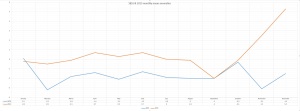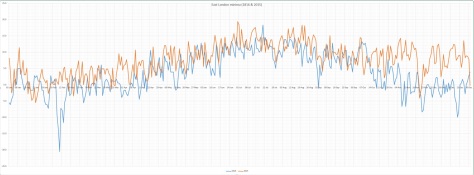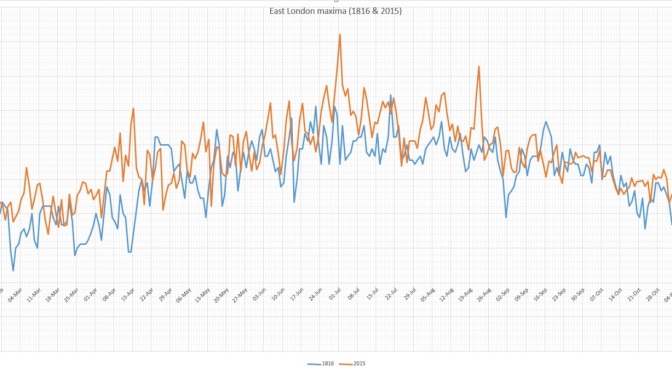Tornadoes, earthquakes, heavy rainfall, abnormally low temperatures, pea-souper fogs and exploding meteors are phenomena that marked the Year Without a Summer around the world 200 years ago. But how did London fair?

When extreme weather affects Britain, such as the floods plaguing northern England and Scotland, conditions in the capital are benign by comparison.
There is not a great deal written in the press about the weather in London in 1816. So, as ever, Luke Howard’s The Climate of London, is a primary reference point.
After a wild end to 1815 that was marked with snow and lightning 1816 started dry, cold and frosty. Though cold by today’s standards January 1816 was fairly average and much warmer than the previous two when the last Thames frost fair was held.

Though the temperature reached 10C on 10th the rest of the month was marked with maxima around 6C and the odd frosty night.
Cold weather returned at the end of the month, turning severe in the second week of February. In the early hours of the 7th heavy snow, driven by gale-force north-easterly winds, brought possibly some of the worst winter weather this area has ever seen. Some 35mm of precipitation is recorded on the 8th – this would normally give at least one foot of level snow that could obviously be whipped up into huge drifts.
Luke Howard described the scene in his diary entry saying the abundance of snow “loaded the trees to their tops and weighed down the smaller shrubs to the ground.”
The snow and polar continental air also produced perfect conditions for a textbook radiative cooling night. The minimum recorded on the 10th: -20.6C has not, as far as I can tell, been repeated since.
To put that into perspective the lowest minimum of the severe winter of 1963 for this area was -12.2C recorded at Greenwich on January 21st. The coldest night I have personally recorded was -10.3C on January 12th 1987.
As often happens with severe cold snaps Howard reported on the 17th the the snow “was mostly gone but very thick ice remains on ponds”; a period of just under a week.
The cold snap saw the mean temperature for February over three degrees colder than average at 0.8C.
As well as keeping meticulous observations in Plaistow, Stratford and Tottenham, Howard always kept an eye on what was going on abroad and noted that earthquake activity was high.
On February 2nd an earthquake that ‘lasted nearly three minutes’ was felt at Lisbon. Three days later an earthquake was felt on Madeira.
“At midnight a severe shock of an earthquake was felt all over the island and the following morning at 4 o’clock another shock was felt.”
An extract of a letter from Captain Welsh of the Claudine described an event of an earthquake felt at sea on the 9th.
On the 9th of February off St Michael’s we experienced very tempestuous weather with a tremendous confused sea. The wind shifting from SW to SE and NE with constant lightning and heavy rain. On the 10th at 8.30pm, the ship then under reefed fore sail and mainstay sail, we were much alarmed by a severe shock of an earthquake which lasted four or five seconds.

Later in the month on 23rd it was reported that the snow in the Grampian hills was at its greatest depth for 20 years.
Howard reported a heavy short snowstorm in the capital on March 4th. He also mentions another earthquake on March 17th that affected the north of England in towns and cities including Doncaster, Bawtry, Blyth, Carlton, Worksop, Sheffield, Chesterfield, Mansfield, Nottingham, Lincoln and Gainsborough.
“A smart shock of an earthquake was perceptibly felt in Lincoln at about 12.50pm. The undulation appeared to be from west to east and lasted from about a minute and a half to two minutes.
“Pictures and other articles hanging on the walls were set in a swinging motion. At Newark also and the neighbouring villages the shock was distinctly felt as well as at Leicester and Loughborough.”
Snowy episodes in the capital lasted well into April. On 12th snow fell for two hours “turning the high ground of Hampstead in the distance white”.
Very high tides were reported on the 15th with “much water out in the marshes”. By the 19th it was noted that the growing season was being severely hampered by the cold weather
April 1816 was nearly 1.5C below average. Despite this, by the 21st, the first swallows began to appear.
May and June were again cold. More than twice the average rainfall in June suggests the weather in the sixth month was very disturbed.
On the 25th a tornado, strong enough to carry objects weighing 60lbs, was reported in the Edgware Road area.
At two o’clock being a still sultry day a whirlwind passed over the nursery ground of Mr Henderson in the Edgware Road which lifted seven lights from the greenhouses and carried them to the height of the highest elm trees, each of the lights weighs 50 or 60lbs at least. At the same time two garden mats were carried to an immense height so that the eye could not distinguish them.
The following day “extremely heavy and prolonged rain from 9am (26th) to 9am on 27th gave 2.95 inches”. This total of over 52mm is notably high though not a record.
Overseas, meanwhile, the weather continued to confound observers. Several inches of snow fell in Quebec on June 8th while a letter from a friend of Howard mentioned a reading of -38F that had been recorded in New Hampshire earlier in the season.
July and August were similarly cold and wet. While events in London had quietened down Howard noted that the Kendal Chronicle was reporting snow on the summit of Helvellyn on July 4th while notable gales in Scotland were affecting ships.
More earthquakes shook locations around the world including one on August 14th in Scotland that caused panic and considerable damage in Inverness. Howard quotes a letter from north of the border:
“Last night, exactly a quarter before 11 o’clock the town of Inverness and the surrounding country was fearfully shook by an earthquake. We fled to the street where we found almost every inhabitant; women and children screaming and a very considerable portion of them naked. Many fled to the fields and there remained for the greater part of the night. Chimney tops were thrown down or damaged in every quarter of the town. The Mason Lodge occupied as an hotel was rent from top to bottom, the north sulk of the chimney partly thrown down one of the coping stones weighing, I should think, from 50lb to 60lb, was thrown to the other side of the street a distance not less than 60 feet.”
Though it is known as the Year without a Summer 1816 was actually only the 8th coolest summer in the local series going back to 1797. There were also 21 wetter summers – the 250mm that fell was actually less than half the rainfall of summer 1960.

A change of month in September failed to bring a change in the weather and the mean temperature continued 2C below the average for the period. Howard mentions a 9-week tour of Europe at this time – his laboratory and climate reading duties left in the hands of his friend and partner, John Gibson.
Howard’s account of his tour explains how excessive summer rains had made life difficult from Amsterdam to Geneva.
“From the sources of the Rhine among the Alps to its embouchure in the German ocean and through a space twice or thrice as broad from east to west the whole season presented a series of storms and inundations. Not meadows and villages alone but portions of cities and large towns lay long underwater; dikes were broken, bridges blown up, the crops spoiled or carried off by torrents and the vintage ruined by the want of sun to bring out and ripen the fruit.
“While the middle of Europe was thus suffering from wet, the north for a time and to a certain extent was parched with drought and public prayers appear to have been ordered about the same time at Riga for rain and at Paris for sunshine.”
On September 16th Howard noted that a ‘dreadful’ hurricane had affected the Caribbean island of Guadalope. “Houses were levelled, plantations destroyed and the soil driven about like dust in a whirlwind.”
October 1816 was a blip during 1816 in that the mean temperature and rainfall were about average though Howard’s records reveal there were four air frosts.
By November the weather began mild but by the 6th the cold had returned with a brief snowy snap. A report from Chester said that day was almost night because of the thickness of the cloud:
“Candles or lamps were obliged to be lighted in all the houses this was succeeded by a slight shower. On Thursday successive falls of hail and rain took place. On Friday the frost was uncommonly severe and on Sunday the snow which fell was above 2ft deep in the streets.”
On the 14th reports came from France that a tempest on the night of the 11th and 12th had wrecked many ships: “winds blowing from the north then SSE”.

A solar eclipse on the 18th was followed by a sustained build in pressure from the 22nd with fog now becoming a problem in the capital.
The Evening Mail on November 27th reported that the problem was particularly acute in South London.
“The atmosphere was so darkened yesterday morning in the vicinity of the metropolis by the thick fog combined with smoke that in some parts it appeared like a cloudy night. In the neighbourhood of Walworth and Camberwell it was so completely dark that some of the coachmen driving stages were obliged to get down and lead their horses with a lantern.”
After the average October November had reverted to type and the month in London finished just over 3C cooler than average.
Pressure began to fall with the arrival of December. On the 12th reports of a meteor were made from Glasgow and Perth. The phenomena sounded spectacular:
“The meteor made its appearance in the SW in the form of a small star and gradually increased in magnitude till it reached the zenith when it subtended an angle nearly equal to that of the full moon. In shape it resembled a paper kite. After passing the zenith it again seemed to diminish in size owing no doubt to its gradually receding from the observer till its altitude was equal to about 30 miles when it exploded like a sky rocket. The report of the explosion, which is described as more tremendous than the noise of the loudest thunder, reached the ear about three minutes after the meteor vanished so that it could not be less than 40 miles distant and probably about 27 miles above the surface of the earth. From the various particulars collected its diameter must have been about 240 yards. The light which it yielded was very considerable being sufficient to render the smallest objects visible.”
Two days later the air pressure fell to its lowest point that year: 966.1mb. In the early hours of the 15th Howard wrote of an earth tremor that lasted 15 seconds.
A brief cold snap arrived on the 19th with the temperature falling to -10C on 21st – by the 26th, however, the temperature reached 10C.
Though December was relatively milder than November the month still finished 1.5C below average with 1.5 times average rain.





That’s an interesting comparison!
It is true that 1816 was an abnormally cool summer, but it was one of many between 1812 and 1823: 1812, 1814, 1817, 1820 and 1823 were all comparably cool to 1816, though none was as wet. It is also true that the very cool years of 1860 and 1879 had much more infamously wet summers, and in fact the winter of 1816/1817 was the mildest for 21 years. Nevertheless no winter during the 1800s or 1810s could be called “mild” even by 20th century standards, let alone compared to what we have seen under the influence of huge greenhouse gas emissions by the mineral-rich states of Australia, Southern Africa and the Persian Gulf monarchies.
It was not until 1821/1822 (the hottest CET fiscal year until 1988) that the first truly “mild” winter since 1795/1796 – and only the fourth in sixty years – occurred.
LikeLike
Reblogged this on Tallbloke's Talkshop and commented:
.
.
Interesting and detailed post
LikeLiked by 1 person
Reblogged this on WeatherAction News and commented:
Really good post. The diary extracts were gold. Thanks. 🙂
LikeLiked by 1 person
Absolutely fascinating account. Thank heavens for global warming and our much more benign present day weather! 😁😁
LikeLiked by 1 person
Fascinating. Thank you for this comprehensive information which I shall use ‘obliquely’ in the Regency story I’m writing.
LikeLiked by 1 person
Many thanks. If you need any details for any particular dates back then do let me know and I’ll have a dig around.
LikeLike
Thank you for your kind offer. I shall pen you into my resource connections. On a subject such as yours, there aren’t that many viable sources. ôô
Thank you, again. Suzy Stewart Dubot
LikeLiked by 1 person
It is a fascinating period. Funnily enough I noticed in your bio your mention of William Wilberforce. A few weeks ago I stayed on his great-great-great-grandson (also) William Wilberforce’s estate. I had a fascinating conversation during a brief tour of the watermill that he wants to renovate.
LikeLike
I lived on Wroughton Road, Battersea, with an aunt for a couple of years. On the corner house is a plate stating ‘On the site behind this house stood until 1904, Broomwood House (formerly Broomfield) where William Wilberforce resided during the campaign against slavery which he successfully conducted in Parliament.’
It thrilled me to think that my aunt’s garden was probably part of his land and that I had walked where he might have walked.
Of course, you have one-upped me by meeting a relative. How great is that?!!
LikeLike